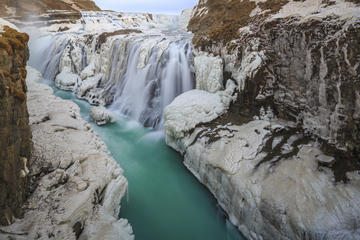Sólheimajökull Glacier
TIME : 2016/2/22 11:29:38

Sólheimajökull Glacier
In a country famous for its glaciers, one of the easiest to explore is Sólheimajökull. A 13.5-square-mile (35-square-kilometer) projectile extending out from the larger Mýrdalsjökull ice cap, Sólheimajökull’s otherworldly landscape of ice ridges, crevasses, sinkholes and streams paired with its southern location make it one of the most popular spots in Iceland for glacial walking and ice climbing. Tours take visitors atop the glacial ice, but also within some of its crevasses and ice caves.
Although Sólheimajökull Glacier could be simply described as a monstrously large piece of ice, it is, in fact, much more than that. The thick ice layers and their contrasting colors have stood witness to the country's seismic and volcanic activities: blue ice is freshly formed; white ice is a bit older; and black debris, are, quite simply, ashes from previous eruptions. The glacier faces the Atlantic Ocean and gives birth to the Jökulsà River.
Unfortunately, like most glaciers, Sólheimajökull is a rapidly receding giant; it is now just a shadow of what it used to be. For the past two decades, it has retreated, on average, one Olympic-length pool per year due to the effects of global warming.
Practical Info
Getting to Sólheimajökull Glacier is quite simple, but visitors should never attempt to hike it (or any of Iceland’s glaciers for that matter) on their own. An experienced guide can provide you with not only proper equipment but also with important safety information. Sólheimajökull Glacier is located roughly 155 kilometers southeast of Reykjavik, and can be accessed via route 1 and unpaved route 221.
